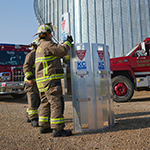Accident investigation and prevention
Uncover root causes of accidents to avoid repeat occurrences.
An accident is defined as "an undesired, unplanned event resulting in physical injury or damage to property." A near miss is defined as "an event that doesn’t result in injury or damage, but has the potential to do so."
Investigating the cause of accidents and/or near misses is one tool in a comprehensive accident-prevention program. If an effective accident investigation is conducted, lessons can be learned and similar incidents can be avoided in the future.
The basic elements of an effective accident-investigation program include:
- Immediately reporting all accidents and near misses to the company
- Having an effective accident-reporting form
- Assigning responsibilities for conducting the accident investigation and reporting the findings to the company
- Determining root cause(s)
- Identifying corrective actions and ensuring they are completed
The 1st element – Immediately Reporting All Accidents – is vital for your company to have an effective accident investigation program because common sense tells us that an accident has to be reported before it can be investigated. Any delay in reporting an accident may hinder the investigation because evidence at the scene of the accident can become disturbed and witnesses' memories can fade over time.
The 2nd element – Having an Effective Accident-Reporting Form – helps ensure proper information is collected during the investigation. Sample forms can be obtained from your agribusiness risk management consultant at Nationwide.
The 3rd element – Assigning Accident Investigation Responsibilities – helps ensure the accident investigation is conducted by someone who’s knowledgeable in the business and understands accident prevention. It also helps ensure all necessary personnel are involved in obtaining all pertinent information. As with any task or responsibility, if it’s not clearly assigned, it’s unlikely to be completed.
The 4th element – Determining Root Cause(s) – is perhaps the most critical element of an effective accident-investigation program. Also known as Root Cause Analysis (RCA), this element requires the investigator to not just look for the direct cause(s) of the accident, but to dig a little deeper and also determine any indirect cause or causes. In other words, RCA helps the investigator look beyond the employee who was "not paying attention," to see if there are other reasons/causes for the incident. Using RCA, the investigator will be in fact-finding mode, instead of the typical "fault-finding mode."
Determining the root cause is as simple as asking the question "Why?" at least 5 times. Typically, the root cause will surface after the 5th time the question is asked. Understanding why an event occurred is the key to developing effective recommendations for corrective action.
An example of how RCA may be used in an accident investigation.
Incident: Henry received a steam burn to his arm and shoulder.
Root Cause Analysis: Ask “why” 5 times. Start with the question, “Why did this incident happen?” For every answer to that question, ask “why” again. Do this 5 times and you will have an enormous number of possibilities.
1. Why did Henry receive a steam burn to his arm and shoulder?
Because the gasket blew out on a flange coupling near where he was working.
2. Why did the gasket blow out on the flange coupling near him?
Because the safety valve did not release the excess pressure in the steam line.
3. Why did the safety valve fail to release?
Because it had not been inspected.
4. Why was the safety valve not inspected?
Because there was no procedure to periodically inspect the valve.
5. Why was there no procedure to periodically inspect the safety valve?
Because no one thought it was important.
Solution: Develop a procedure to require safety valves to be periodically inspected, which should greatly reduce the potential for the exposure.
As this example shows, going beyond the obvious cause of the accident — gasket failure — results in determining the underlying causes that can increase the chance of preventing a recurrence of this incident.
The 5th and final element – Identifying and Ensuring the Completion of Corrective Actions – is vital to preventing repeat accidents and helping employees feel safe and respected within your organization. The worst thing that can happen when trying to establish a safety culture is to conduct the accident investigation and NOT complete the corrective actions or NOT ensure they stay in place. This is why it’s important to assign responsibility for corrective actions and to track the progress of their completion.
As already stated, the purpose of an accident-investigation program is to determine the causes of the accident and not to just find someone to blame and punish. Once this approach to accident investigation is adopted, including determination of the root cause(s) and implementing the necessary corrective actions, then recurrence of an incident is unlikely and your workplace will be a better place to work.
For assistance in developing an accident-prevention program for your organization, please contact your agribusiness risk management consultant at Nationwide.

 >
>

 >
>
 >
>